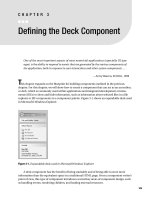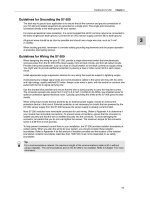Installing the deck ledger
Bạn đang xem bản rút gọn của tài liệu. Xem và tải ngay bản đầy đủ của tài liệu tại đây (69.63 KB, 3 trang )
I
nstalling the Deck Ledger
OVERVIEW
Introduction
It attaches the deck to your house and it is also provides the reference point for laying out the deck for
construction. Because of its importance, the ledger must be correctly positioned and fastened very securely to
the house.
Pressure-treated lumber is the preferred material for the ledger. It is very sturdy and resists rot and pests. It
should be secured directly to a header joist or to a masonry foundation for maximum strength. For installation
into a header joist, you will use lag bolts. Masonry installation requires anchors that expand as the lag bolts are
screwed in.
Time to complete this project depends on the size of the deck and the level of help available, the times listed
here are for two people on a 10’x 30’ deck with the house defining two sides of the deck.
• Beginner - 4 to 5 hours
• Intermediate - 3 to 4 hours
• Advanced - 2 to 3 hours
Install the ledger at least 1" below any doors that will open out onto the new deck. This will help
prevent water, ice and snow from building up and leaking under the bottom door seal.
When marking the height for cutting the siding to fit the ledger, remember that 2" x 6"
lumber is typically only 5-1/2" wide.
STEPS
1.
Reference your deck plans to determine the exact location and size of the
ledger board. You need to cut out the siding on your house where the ledger
will be installed. On the side of the house, use a level and mark the siding to
match the size of the ledger. The length of the cut out area will actually be
longer than the ledger to allow room for the outside joists and any
decorative trim you plan to install.
2.
Set the depth of your circular saw to the exact thickness of your siding. You
only want to remove the siding and leave the sheathing underneath intact.
Cut around the marked area with the saw.
3.
There are probably some areas, such as corners, that you could not get to
with the circular saw. Use a chisel with the flat side facing the finished edge
and cut loose any remaining areas.
4.
Measure the length of the cutout area for the metal drip edge. It will need to
span the entire length of the opening. Cut the metal drip edge using tin
snips. Slip it under the siding. It should stay wedged in position for now.
5.
Measure the length needed for the ledger. It will be shorter than the cutout.
Mark the ledger lumber and squarely cut it to length. Put the ledger in
position in the cut out area. Make sure you center it in the cutout area,
leaving room (about 1-1/2 inches) for the outside joists and trim on each
side. Tack the ledger in place with a few nails or screws and a screw gun.
6.
About 1-1/2" from the top and bottom edges, drill pilot holes. Make each set
of pilot holes about 2 feet apart from each other. Then, using a 1" paddle
bit, retrace your steps and drill 1/2" deep holes to countersink the washers
and heads of the lag bolts.
7.
Using a socket wrench, screw in lag bolts with washers in each of the holes.
The lag bolts should be about 4" long so that they go through the ledger, the
sheathing and into the header joist.
8.
Now that the ledger is securely in place, take silicone caulk and fill in the
holes with the lag bolts. Then run a bead of caulk along the seam between
the siding and drip edge above the ledger.
SHOP LIST
Materials Needed
•
Pressure-treated 2" x 6" lumber
•
Lag bolts
•
Washers
•
Silicone caulk
•
16d nails Drip edge
Tools Needed
•
4-foot level
•
Circular saw
•
Hammer
•
Chisel
•
Tin snips
•
Socket set
•
Hammer Drill
•
Drill bits









